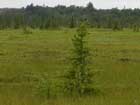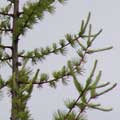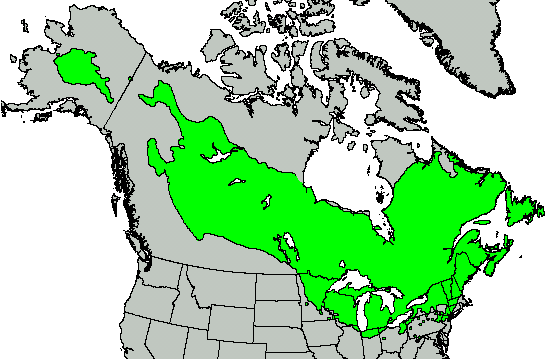Conservation Status

Larix laricina
(DuRoi) K. Koch 1873
Common names
American larch, eastern larch, black larch, red larch, eastern tamarack, hackmatack; mélèze laricin [French]; mashkiigwaatig [Ojibwe].
Taxonomic notes
Syn: Pinus laricina DuRoi 1771; Larix alaskensis W. Wight; L. laricina var. alaskensis (W. Wight) Raup (Parker 1993).
Disjunct Alaskan populations of Larix laricina, originally described as Larix alaskensis on the basis of narrower cone scales and bracts, are indistinguishable from other populations of the species (Parker 1993). However, analyses using mtDNA and cpDNA markers, as well as fossil pollen, have identified three distinct groups: eastern North America, western North America and Alaska. These presumably derive from the occurrence of the species in different glacial refugia, with two distinct glacial lineages south of the Laurentide ice sheet, and two others at northern refugia located in Beringia and Labrador (Warren et al. 2016). It should be noted that the analysis contained no samples from BC, Yukon or Northwest Territories, and only one from Alberta, so genetic structure may be more complex and additional refugia may have existed.
Description
"Trees to 20 m; trunk to 60 cm dbh; crown narrow, branches sparse. Bark of young trees gray, smooth, becoming reddish brown and scaly, inner layer red-purple. Branches horizontal or slightly ascending; twigs orange-brown, glabrous. Buds dark red, subtended by ring of hairlike bracts, glabrous. Leaves of short shoots 1-2 cm × 0.5-0.8 mm, 0.3-0.5 mm thick, keeled abaxially, rounded adaxially, pale blue-green; resin canals 10-20 µm from margins. Seed cones 1-2 × 0.5-1 cm, usually on curved stalks 2-5 × 2-2.5 mm, sometimes sessile on long shoots; scales 10-30, margins entire, brown-strigose to -tomentose at base; bracts mucronate or tipped by awn to 1 mm, hidden by mature scales, at first dark red to violet, later turning yellow-brown. Pollen 53-65 µm diam. Seeds with bodies 2-3 mm, wings 4-6 mm. 2n=24" (Parker 1993). See García Esteban et al. (2004) for a detailed characterization of the wood anatomy.
Distribution and Ecology
Canada: Alberta, British Columbia, Manitoba, New Brunswick, Newfoundland, Northwest Territories, Nova Scotia, Nunavut, Ontario, Prince Edward Island, Québec, Saskatchewan, Yukon; France: St. Pierre and Miquelon; USA: Alaska, Connecticut, Illinois, Indiana, Maine, Maryland, Massachusetts, Michigan, Minnesota, New Hampshire, New Jersey, New York, Ohio, Pennsylvania, Rhode Island, Vermont, West Virginia, Wisconsin. Found at 0-1200 m elevation in boreal forests, typically in wet, poorly drained sphagnum bogs and muskegs, also on moist upland mineral soils (Parker 1993). See also Thompson et al. (1999). Hardy to Zone 2 (cold hardiness limit between -45.6°C and -40.0°C) (Bannister and Neuner 2001). Grows as krummholz at the arctic (and locally, alpine) timberline (pers. obs. 1991, 2011).
Distribution data from USGS (1999). Points plotted as tree icons represent isolated or approximate locations.
Remarkable Specimens
The largest recorded specimen was 95 cm dbh and 25.0 m tall with a 14.0 m crown spread when last measured in 2015; it is located in Carroll, New Hampshire (American Forests 2023). A past champion was significantly larger: height 33 m, dbh 110 cm, crown spread 14 m, in Phoenix, Maryland (American Forests 1996).
The oldest reported is 371 years, a crossdated date (Payette and Gagnon 1979).
Ethnobotany
The strong durable wood is used for railway ties, pilings, and posts; it formerly was used for boat construction. Slow-growing trees develop wood with high resin content, making it decay resistant but limiting its value as pulpwood. The bark contains a tannin that has been used for tanning leather. Although tamarack is the most rapidly growing boreal conifer under favorable conditions, it is of little commercial interest because of insect and disease problems and its poor pulping properties (Parker 1993).
Observations
Easily seen in boreal forest habitats through the northern portions of its range, for example in Denali National Park (AK), Riding Mountain National Park (Man.) and Acadia National Park (ME).
Remarks
The epithet means "like a larch"; the name was given when it was classified as a species of Pinus.
Tamarack is the provincial tree of Northwest Territories.
Citations
American Forests 1996. The 1996-1997 National Register of Big Trees. Washington, DC: American Forests.
American Forests 2023. 2021 National Register of Champion Trees, accessed 2023.02.22.
Koch, K. H. E. 1873. Dendrologie, vol. II. Erlangen (p. 263).
Warren, Emile, Guillaume De Lafontaine, Sébastien Gérardi, Sauphie Senneville, Jean Beaulieu, Martin Perron, Juan Pablo Jaramillo‐Correa, and Jean Bousquet. 2016. Joint inferences from cytoplasmic DNA and fossil data provide evidence for glacial vicariance and contrasted post‐glacial dynamics in tamarack, a transcontinental conifer. Journal of Biogeography 43(6): 1227–41. https://doi.org/10.1111/jbi.12675.
See also
Burns and Honkala (1990).
Elwes and Henry 1906-1913 at the Biodiversity Heritage Library (as L. americana) (Photo). This series of volumes, privately printed, provides some of the most engaging descriptions of conifers ever published. Although they only treat species cultivated in the U.K. and Ireland, and the taxonomy is a bit dated, still these accounts are thorough, treating such topics as species description, range, varieties, exceptionally old or tall specimens, remarkable trees, and cultivation. Despite being over a century old, they are generally accurate, and are illustrated with some remarkable photographs and lithographs.
FEIS database.
MacKinnon et al. (1992).
Owens and Simpson (1986).
Parker and Dickinson (1990).
Powell (1987).



